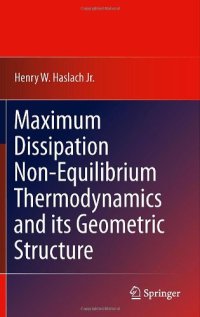
Ebook: Maximum Dissipation Non-Equilibrium Thermodynamics and its Geometric Structure
Author: Henry W. Haslach Jr. (auth.)
- Genre: Technique // Energy
- Tags: Engineering Thermodynamics Heat and Mass Transfer, Thermodynamics, Biomaterials, Mechanical Engineering
- Year: 2011
- Publisher: Springer-Verlag New York
- Edition: 1
- Language: English
- pdf
Maximum Dissipation Non-Equilibrium Thermodynamics and its Geometric Structure explores the thermodynamics of non-equilibrium processes in materials. The book develops a general technique to construct nonlinear evolution equations describing non-equilibrium processes, while also developing a geometric context for non-equilibrium thermodynamics. Solid materials are the main focus in this volume, but the construction is shown to also apply to fluids. This volume also:
• Explains the theory behind a thermodynamically-consistent construction of non-linear evolution equations for non-equilibrium processes, based on supplementing the second law with a maximum dissipation criterion
• Provides a geometric setting for non-equilibrium thermodynamics in differential topology and, in particular, contact structures that generalize Gibbs
• Models processes that include thermoviscoelasticity, thermoviscoplasticity, thermoelectricity and dynamic fracture
• Recovers several standard time-dependent constitutive models as maximum dissipation processes
• Produces transport models that predict finite velocity of propagation
• Emphasizes applications to the time-dependent modeling of soft biological tissue
Maximum Dissipation Non-Equilibrium Thermodynamics and its Geometric Structure will be valuable for researchers, engineers and graduate students in non-equilibrium thermodynamics and the mathematical modeling of material behavior.
Maximum Dissipation: Non-Equilibrium Thermodynamics and its Geometric Structure explores the thermodynamics of non-equilibrium processes in materials. The book develops a general technique created in order to construct nonlinear evolution equations describing non-equilibrium processes, while also developing a geometric context for non-equilibrium thermodynamics. Solid materials are the main focus in this volume, but the construction is shown to also apply to fluids. This volume also: •Explains the theory behind thermodynamically-consistent construction of non-linear evolution equations for non-equilibrium processes •Provides a geometric setting for non-equilibrium thermodynamics through several standard models, which are defined as maximum dissipation processes •Emphasizes applications to the time-dependent modeling of soft biological tissue Maximum Dissipation: Non-Equilibrium Thermodynamics and its Geometric Structure will be valuable for researchers, engineers and graduate students in non-equilibrium thermodynamics and the mathematical modeling of material behavior.